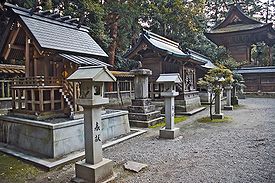Setsumatsusha

Sessha(Nhiếp xã,auxiliary shrine)andmassha(Mạt xã,undershrine),also callededa-miya(Chi cung,branch shrines)[1](collectively known assetsumatsusha(Nhiếp mạt xã)[2][note 1]) are small or miniature shrines entrusted to the care of a larger shrine, generally due to some deep connection with the enshrinedkami.[3]
The two terms used to have legally different meanings, but are todaysynonyms.Setsumatsushacan lie either inside(Cảnh nội nhiếp mạt xã,keidai setsumatsusha)or outside(Cảnh ngoại nhiếp mạt xã,keigai setsumassha)the main shrine's premises.Setsumatsushaare usually 1x1kenin size. They can however be as small asbeehivesor relatively large and have 1x2, 1x3 or even, in one case, 1x7 bays.[4]
History
[edit]The practice of buildingsesshaandmasshashrines within ajinjapredateswritten history.The earliestsetsumatsushausually had some strong connection to the history of the area or the family of the enshrinedkami.
During theHeian period,Ise Shrineused to make a distinction between the two types based on whether a shrine belonged to theEngishikiJinmyōchōlist (sessha) or to theEnryaku gishikichōlist (massha).[5]
From theJapanese Middle Agesonwards, at other shrines popularkamilikeHachiman,Inarior Gozu Tennō(Ngưu đầu thiên vương)were often enshrined[note 2]insetsumatsusha,but no clear distinction between the two terms was made. From theMeiji periodto theSecond World War,a shrine dedicated to family members of akami,to the violent side of a kami(Hoang hồn,aramitama),or thekamiof the region where the main shrine was, were to be consideredsesshawith a higher rank than the rest, which were calledmassha.[5]When theshakaku(Xã cách)shrine ranking system was abolished in 1946, legally the distinction disappeared, but both terms remained in use out of habit.
Betsugu are another kind of auxiliary shrine their relationships to the main shrine are similar to that of Massha and Sessha.[6]The term is most notable for the extensive betsugu atIse Grand Shrine.[6]
Architectural style
[edit]
Being true shrines,setsumatsushahave most features other types of shrines have, including doors and often stairs. However, theMisedana-zukuri(Kiến thế bằng tạo or điếm bằng tạo,showcase style)is a style normally used only insesshaandmassha.It owes its name to the fact that, unlike other shrine styles, it doesn't feature a stairway at its entrance, and the veranda is completely flat.[4]Miniature stairways can however be present. They can be eithertsumairi(Thê nhập),that is have the entrance under the gable, or, more frequently,hirairi(Bình nhập),that is, have the entrance on the side parallel to the roof's ridge (see examples in the gallery). Apart from the lack of a staircase, such shrines belong to thenagare-zukuriorkasuga-zukuristyles.
Architectural examples
[edit]-
A largesessha
-
AmasshaatIse Shrine
-
A row ofmassha
-
Ahirairisessha
-
Atsumairisessha
Notes
[edit]References
[edit]- ^IwanamiKōjien(Quảng từ uyển)Japanese dictionary, 6th Edition (2008), DVD version.
- ^Mure, Jin."Sessha, massha"(in Japanese). Shokagukan. Archived fromthe originalon 19 December 2012.Retrieved9 March2010.
- ^"Sessha – Massha"(in Japanese). Yahoo! Japan. Archived fromthe originalon 19 December 2012.Retrieved5 December2009.
- ^ab"JAANUS".aisf.or.jp.Retrieved15 March2016.
- ^abMori, Mizue."Sessha, Massha".Encyclopedia of Shinto.Retrieved5 December2009.
- ^ab"Betsugū | quốc học viện đại học デジタルミュージアム".






